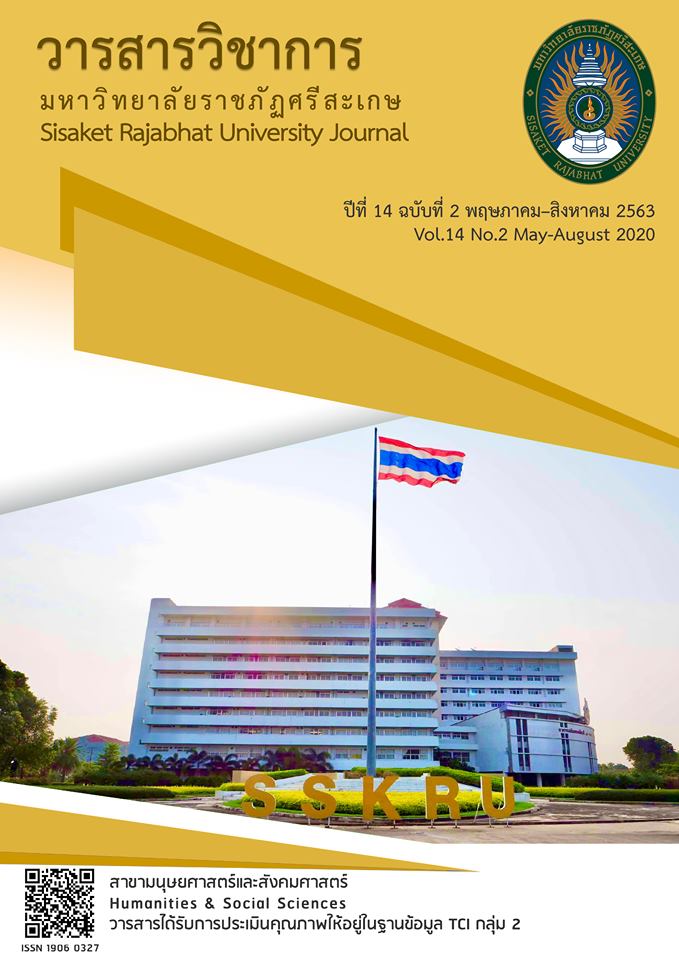การพัฒนาแนวคิดวิทยาศาสตร์ด้วยการจัดการเรียนรู้โดยใช้บริบทเป็นฐานร่วมกับกลยุทธ์ช่วยจำแบบนีโมนิค (Mnemonic) เรื่อง ระบบหมุนเวียนเลือด ในรายวิชาชีววิทยาของนักเรียนชั้นมัธยมศึกษาปีที่ 5
Main Article Content
บทคัดย่อ
การวิจัยครั้งนี้จัดทำขึ้นเพื่อพัฒนาแนวคิดวิทยาศาสตร์ของนักเรียนชั้นมัธยมศึกษาปีที่ 5 ด้วยการจัดการเรียนรู้โดยใช้บริบทเป็นฐานร่วมกับกลยุทธ์ช่วยจำแบบนีโมนิค ให้อยู่ในระดับแนวคิดวิทยาศาสตร์สมบูรณ์ กลุ่มเป้าหมายในการวิจัยครั้งนี้ คือ นักเรียนชั้นมัธยมศึกษาปีที่ 5/10 จำนวน 25 คน โรงเรียนสารคามพิทยาคม ภาคเรียนที่ 2 ปีการศึกษา 2562 โดยเป็นการวิจัยเชิงปฏิบัติการ ดำเนินการวิจัย 3 วงจรปฏิบัติการ เครื่องมือที่ใช้ในการวิจัยประกอบไปด้วย 1) แผนการจัดการเรียนรู้ ด้วยการจัดการเรียนรู้โดยใช้บริบทเป็นฐานร่วมกับกลยุทธ์ช่วยจำแบบนีโมนิค จำนวน 9 แผน 2) แบบวัดแนวคิดวิทยาศาสตร์แบบอัตนัย จำนวน 18 ข้อ 3) แบบสังเกตพฤติกรรมแบบตรวจสอบรายการ และ 4) แบบสัมภาษณ์แบบกึ่งโครงสร้าง
ผลการวิจัยพบว่า วงจรปฏิบัติการที่ 1 นักเรียนมีระดับแนวคิดวิทยาศาสตร์สมบูรณ์ จำนวน 5 คน คิดเป็นร้อยละ 20 วงจรปฏิบัติการที่ 2 นักเรียนมีระดับแนวคิดวิทยาศาสตร์สมบูรณ์ จำนวน 13 คน คิดเป็นร้อยละ 52 วงจรปฏิบัติการที่ 3 นักเรียนมีระดับแนวคิดวิทยาศาสตร์สมบูรณ์ จำนวน 16 คน คิดเป็นร้อยละ 64
Article Details
1. เนื้อหาและข้อมูลในบทความที่ลงตีพิมพ์ในวารสารวิชาการมหาวิทยาลัยราชภัฏศรีสะเกษ ถือเป็นข้อคิดเห็นและความรับผิดชอบของผู้เขียนบทความโดยตรง ซึ่งกองบรรณาธิการวารสาร ไม่จำเป็นต้องเห็นด้วย หรือร่วมรับผิดชอบใด ๆ
2. บทความ ข้อมูล เนื้อหา รูปภาพ ฯลฯ ที่ได้รับการตีพิมพ์ในวารสารวิชาการมหาวิทยาลัยราชภัฏศรีสะเกษ กองบรรณาธิการไม่สงวนสิทธิ์ในการคัดลอกบทความเพื่อการศึกษา แต่ให้อ้างอิงแหล่งที่มาให้ครบถ้วนสมบูรณ์
เอกสารอ้างอิง
Bakken, J. P., & Simpson,C. G. (2011). Mnemonic Strategies: Success for the Young-Adult Learner. The Journal of Human Resource and Adult Learning. Vol.7 (pp.79-85).
De Jong, O. (2008). Context-based chemical education: How to improve it?. Chemical Education International. Vol.8 (pp.1-7).
Gilbert, J. K. (2006). On the Nature of “Context” in Chemical Education. International Journal of Science Education. Vol.28 (pp.957-976).
Pramchoo, J., Sreethunyoo A., & Meesuk L. (2010). Development of Grade-11 Students
Understanding about Rate of Reaction and Attitude Toward Learning Chemistry
by Using Context-Based Learning Activities. KKU research journal. Vol.15
(pp.317-330). Khon Kaen: Khon Kaen university. [In Thai]
Pungsamrong, R., Chauvatcharin N., & Panprueksa K. (2018). Effects Of Inquiry Learning
Cycle(5es)Together With mnemonic “Camr”For Enhancing Learning
Achievement And Attitude Towards Biology Of 10th Grade Students.
Veridian E-Journal. Vol.3 (pp.2473-2494). Bangkok:
Silpakorn University. [In Thai]
Rozental, A., & Carlbring, P. (2014). Understanding and treating procrastination: A review
of a common self-regulatory failure. Psychology. Vol.5 (pp.1488–1502).
Saelim, W., Tanak, A., & Pradermwong K. (2015). The Development of Grade 10 Students’
Conception in The Chemical Basis of Life Unit Using Context-Based Learning.
Kasetsart Educational Review. Vol.30 (pp. 63-75). Bangkok:
kasetsart university. [In Thai]
Sternberg, R. J., & Sternberg, K. (2012). Cognitive psychology. (6 th ed). California: Wadsworth.
Suksanchananun, C. (2012). Alternative : The development of junior high school
students'' conception and conceptual transferability of heat by
contextual learning. (Master of education). Bangkok:
kasetsart university. [In Thai]
Westbrook, S. L., & Marek , E. A. (1992). A cross-age study of student understanding of the concept of homeostasis. Journal of Research in Science Teaching. Vol.29 (pp.51-61).


